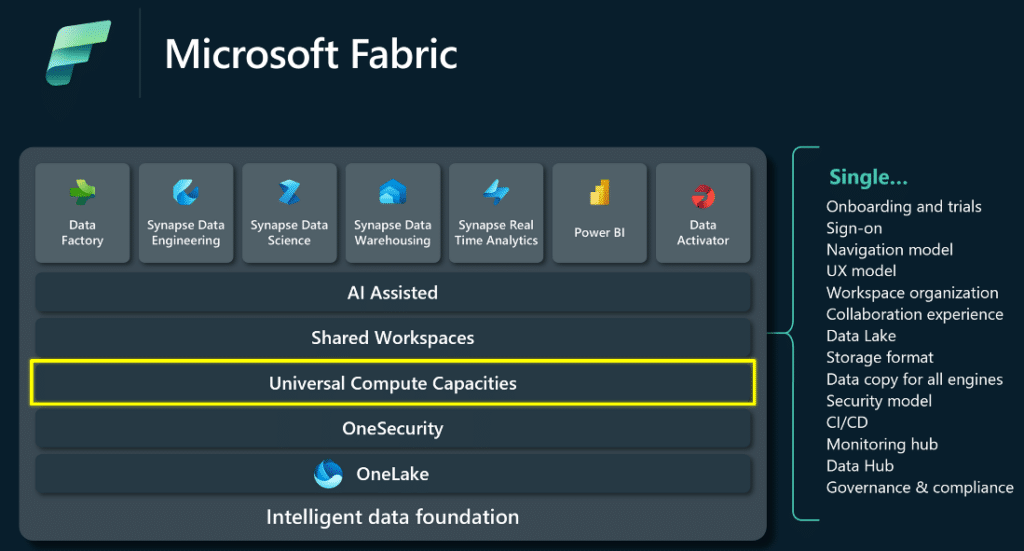
Global Content Lead - Tech & Consulting
Subscribe to the newsletter
Microsoft has recently introduced Microsoft Fabric, a novel data storage and management solution. This platform incorporates various functionalities such as a data lake, diverse computing configurations, sophisticated data governance, and an extensive application surface.
Microsoft Fabric Capacity stands out as a key element within the comprehensive suite of Fabric components. This article delves into the essence of Fabric capacities, their significance and explores how strategic approaches like bursting and smoothing can enhance data performance.
What are capacities in Microsoft Fabric?

Fabric is a single data platform with shared architecture, governance, billing, and experiences. Capacities provide the processing power behind all of these experiences. They can be readily expanded with an SKU upgrade and provide a straightforward, uniform method of scaling resources to match customer demand.
Simply put, Microsoft Fabric capacities are the foundation of the Microsoft Fabric platform, providing the compute resources that power all the experiences in the platform, from data modeling and data warehousing to business intelligence and machine learning. Capacities are also used to run other Microsoft services, such as Azure Data Studio and Power BI Desktop.
Each capacity is a dedicated set of resources that is reserved for exclusive use. This means you can be confident that your applications and workloads will have the resources they need to run smoothly. Capacities are also scalable, so you can easily add more resources as your needs grow.
Acquire a capacity once and utilize it to empower all Fabric functionalities.
The simplicity and adaptability of Fabric’s licensing model are based on capacities. With Fabric, you can power all of your Fabric experiences with a single capacity, saving you the trouble of setting up numerous services for each project.
There are three ways to obtain capacities if you’re just starting out: through the Fabric trial, Power BI Premium capacities, and Fabric capacities. You are automatically eligible to try out Fabric if you currently have a Power BI Premium capacity. You may learn about enabling fabric here.
With a FREE 60-day free Fabric trial, you can test fabric experiences with 64 capacity unit seconds (CUs) of throughput. After that, you can load-test the trial capacity and select an SKU size based on demand. The amount of capacity throughput, expressed in CUs, is determined by choosing a capacity size. In addition to the flexibility of all the Fabric capabilities, organizations can enjoy predictable spending thanks to the flexibility of shared compute, all for one set price.
On June 1, Microsoft unveiled the accessibility of Fabric pay-as-you-go capacities for procurement within Azure. These capacities commence with an exceptionally low initial price point. Moreover, the arrival of reserved instance capacities promises even more substantial discounts for those opting to pre-commit.
Bursting and smoothing in Fabric capacity
Bursting: Optimizing performance with explosive power for running Fabric experiences.
Bursting lets you expedite the completion of a task by using additional compute resources beyond what has been purchased. For instance, bursting could use 256 CUs to finish a job in 15 seconds as opposed to running it on 64 CUs and finishing it in 60 seconds.
- Bursting is a SaaS feature that doesn’t need user management. To maximize performance, Microsoft managed virtualized compute resources are pre-provisioned by the capacity platform in the background.
- The compute spikes generated as a result of bursting won’t cause throttling because of the smoothing policies discussed herewith.
Smoothing: Enhancing operational efficiency by enabling you to anticipate and plan for average usage rather than peak loads.
A capacity performing multiple jobs may experience an abrupt spike in compute demand that is greater than what can be accommodated by the capacity purchased. Here, smoothing makes capacity management easier by spreading the evaluation of compute to guarantee that your jobs are performed smoothly and effectively.
- For interactive jobs run by users: capacity demand is usually smoothed over 5 minutes to mitigate short-term temporal spikes.
- For scheduled or background jobs: capacity demand is distributed across a 24-hour timeframe, eliminating concerns about job scheduling or contention.
Smoothing does not affect execution time because it is always at peak performance! Using smoothing, you can simply size your capacity based on average usage rather than peak usage.
Capacity management, monitoring and cost management

Within a single tenant, different users may provision multiple capacities. As a result, business units can buy and manage capacities independently, each supporting its own creators and projects and making cost management and control simple.
Fabric capacities can be accessed via the “Fabric Capacity” tab of the capacity settings section of the Fabric admin portal. On this tab, you can assign workspaces to your Fabric capacities, manage them, and add other users to the capacity.
The Microsoft Fabric utilization and metrics app offers a centralized dashboard for tracking expenses and usage in addition to fabric capacities. Additionally, you can optimize your capacity usage and comprehend your spending across workloads with Azure cost management.
Capacities and regions
You have the option to choose the deployment region for a capacity once it has been provisioned through the Azure portal. All of the data for workspaces that are assigned to a capacity will be stored there, and the compute will also be located there.
Maintaining the appropriate data residency requirements is possible for your Fabric tenant by provisioning capacities for various regions.
How to buy Microsoft Fabric capacities?
As mentioned above, Microsoft Fabric capacities are available for purchase as a pay-as-you-go model via the Azure portal. To learn more about Microsoft Fabric capacity pricing, here.
If you have existing Power BI Premium subscriptions, you can turn on the Fabric preview switch and use the capacities to power all Fabric workloads without performing any other action. One capacity can support multiple workloads simultaneously and doesn’t require pre-allocation across those workloads. Furthermore, it can be shared among various users and projects without restrictions on the number of workspaces or creators using it.
To explore the potential value of Microsoft Fabric for your business and assess whether investing in Fabric Capacities is the right choice, contact us at marketing@confiz.com.



